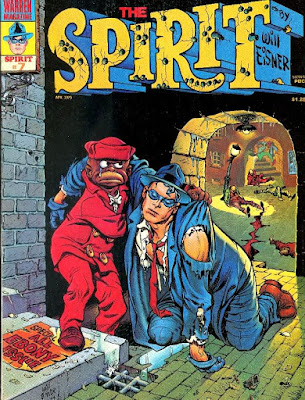Dick Tracy recently concluded a storyline involving the Spirit (Dec. 2016 through Mar. 2017). Last week, I shared some of the basic backgrounds for Will Eisner's creation (see:
Part 1). But importing a comic book character from the 1940s isn't just as simple as drawing it accurately. Mike Curtis and Joe Staton had to strike a delicate balance between the accepted canon and modern sensibilities.
 |
Ebony White was always a valuable aide for the Spirit.
But sensibilities for acceptable cartoon
exaggeration have changed greatly
since the 1940s. |
A Changing Cast of Characters
The Spirit had a fairly stable cast of supporting characters. There was Police Commissioner Dulan, who was one of the few people who knew the Spirit was resurrected policeman Denny Colt. Dulan was the reason the Spirit was able to work with -- and under the sanction -- of the police department.
Ellen Dolan, the commissioner's daughter, was the love interest of Denny Colt/the Spirit. She was more than just a convenient damsel in distress. Ellen Dolan was competent, capable, and often more than a match for the men in her life.
Like many masked crime fighters of the 1940s, the Spirit had a youthful sidekick. Ebony White was drawn as an African American stereotype, but his character was anything but.
Most comic scholars agree that Will Eisner wasn't inherently racist, just a product of his time. But times change. By 1949 it was clear that Ebony had to go.
And so he was replaced by Sammy Strunk, who would fill out remaining three years of the Spirit's run as his sidekick. For true Spirit fans, Ebony White remains the Spirit's true sidekick. But for new readers in 2017? No way.
 |
(L-R) Sammy Strunk, Commissioner Dulan, the Spirit. I do wonder how
he managed to board a commercial flight with a mask and traveling
under an alias... |
Singing a song
Although Ebony White was gone, he certainly wasn't forgotten. Staton and Curtis had the Spirit singing the song "Every Little Bug" in several sequences. The tune first appeared in a Spirit comic in 1946, and was a running gag through 1950.
The tune was written by Ebony White, and was on the Hit Parade (at least in the Spirit's world). Sheet music for the tune was also published in the real world (Will Eisner, lyrics; Bill Harr, music), although it was less successful outside of the comic strip.
The Lunar Connection
In the course of Staton and Curtis' story, it's mentioned that the Spirit has been to the moon.
By 1951 appeal for the masked hero had pretty much run its course. After World War II superhero comics were on the decline, and popular tastes were changing. Will Eisner employed Wally Wood, one of the premier science fiction comic artists, to help steer the Spirit into a new direction.
In 1952, the comic was rebranded "
Outer Space" with the Spirit parenthetically mentioned. The six-part story involved the first moon expedition. The crew was a mix of scientists and criminals, earning their pardon by participating in was could well be a fatal mission. The Spirit came to keep the cons in line.
It was a gritty, mostly somber tale with stunning artwork. And it pretty much marked the end of the series. After the Spirit returned to Earth, there was one further adventure (with the Spirit as a UFO hunter), and the comic was canceled.
Since the Moon also played an important part of Chester Gould's Dick Tracy strip, it seemed only natural that the subject arises in conversation.
Next week: the ever-expanding Tracyverse


















































